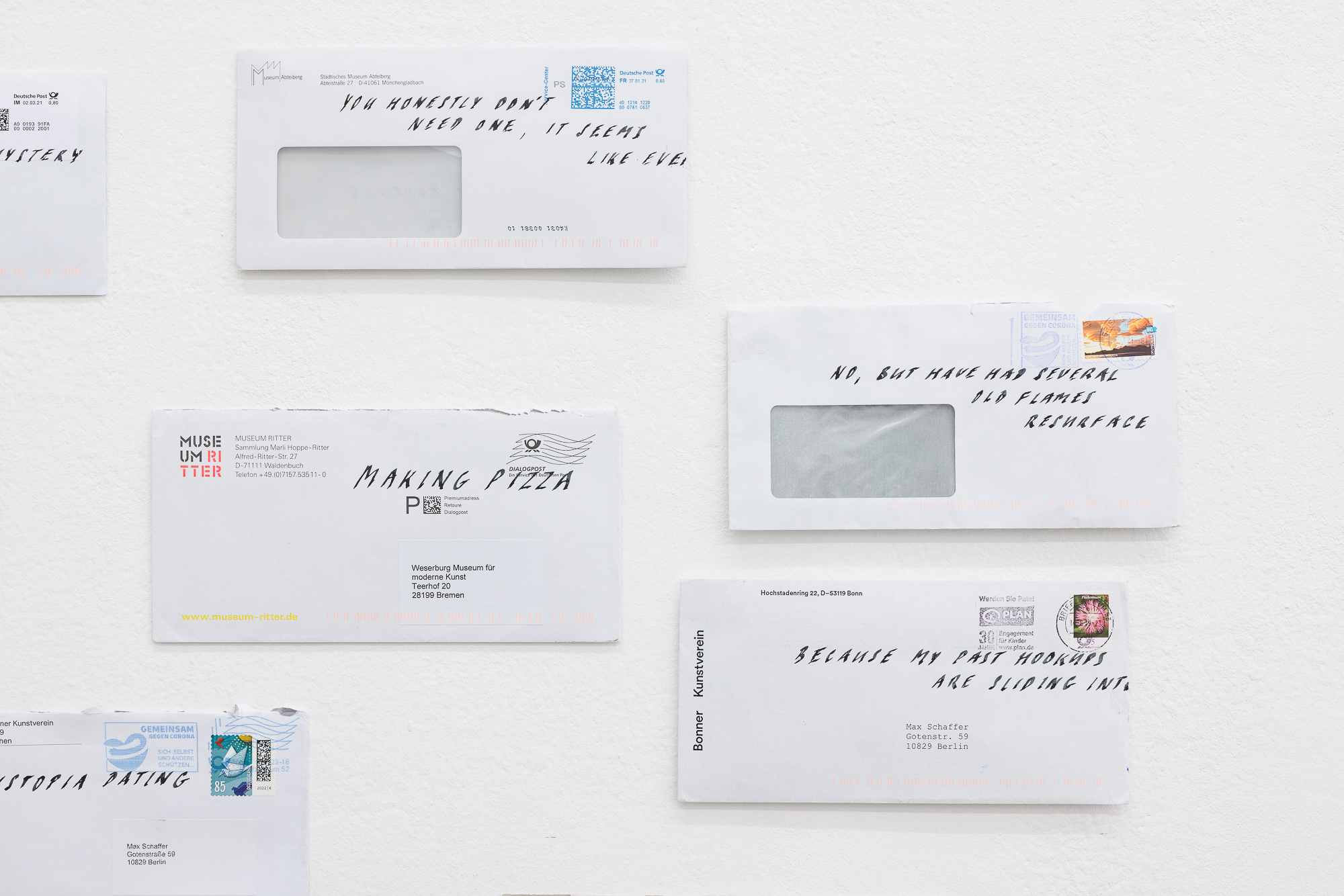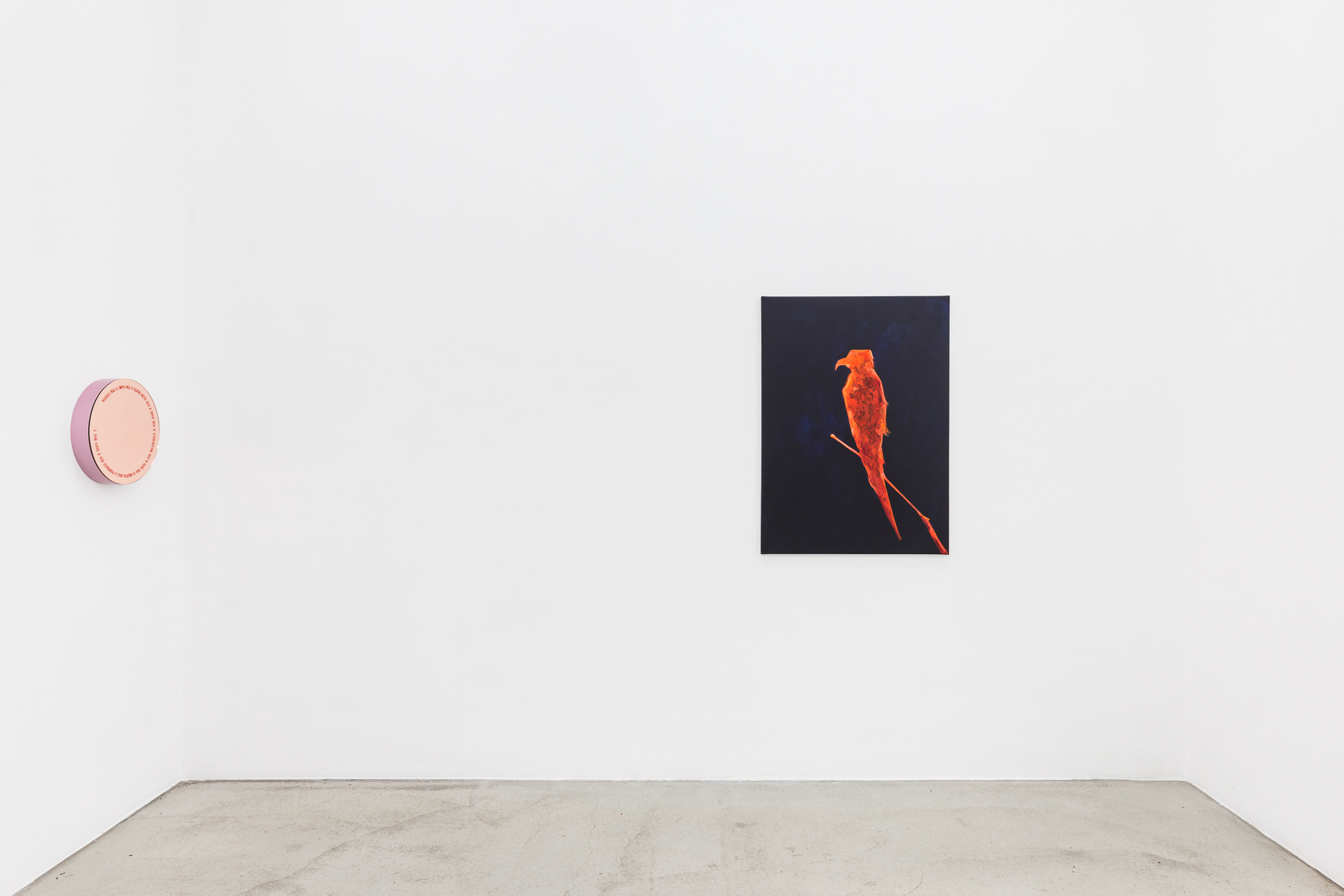
Max Schaffer, Untitled (LETTERS), ink on envelopes, dimensions variable, 2020-2022 (ongoing)
LOVE LETTERS
curated by Paul Feigelfeld & Kathi Senn
!MEDIENGRUPPE BITNIK GERRIT FROHNE-BRINKMANN ROZAFA ELSHAN
RICHARD HOECK DAVID LINK BARBARA MUNGENAST ALEXANDER RUTHNER ELFIE SEMOTAN
STEPHANIE STERN MAX SCHAFFER MARINA SULA HANS WEIGAND RUTH WOLF-REHFELDT
“Es gibt keine Postmoderne. Es gibt nur die moderne Post.” Niklas Luhmann zu Friedrich Kittler, Rauchertaxi, ohne Datum.
In times of war, climate catastrophe, algorithmic matchmaking, total surveillance, shitstorms and hate speech, the world needs love letters. While a universal form, love letters at the same time are the most personal and intimate medium of communication: They carry with them confessions, hopes, dreams, desires, insecurities, courage, admiration, surprise, fear of rejection, or ideally the condition of possibility for a dialogue, transformation, growth, and a future. In many ways, art has similar features and qualities. The show brings together an entirely heterogeneous group of artists and works in various media to open up a complex spectrum of (non-)human emotion and reflect on ways of being together.
David Link’s eponymous installation LoveLetters was first shown at dOCUMENTA(13), 2012. In it, the artist and computer archeologist Link romantically resurrects the earliest electronic, programmable and universal calculating machine worldwide: the Manchester University Computer or MUC. In 1953 and out of nowhere, it started to produce strange and touching love letters, addressed to anonymous people, or perhaps machines. The present version Love Letters – core is also based on the original source code by Christopher Strachey, a friend and colleague of Alan M. Turing, from 1951, and accompanied by two photographic prints of love letters on vintage CR tubes in the first on-screen font ever.
Rozafa Elshan and Stephanie Stern met only 3 months ago. Since then, they have built a collective body of work mapped out by assemblages and their processes in space. The large table installation is a complex coup de foudre of objects and their correspondences, negotiating meanings, media and messages. The present work came into being right before the opening when the artists met again and transformed their exchange over distance into a performative staging and séance on site.
Ruth Wolf-Rehfeldt is one of the absolute pioneers of mail art, visual poetry and typewriting. Born in 1932, her artistic work developed in post-war Germany and the GDR. In 1990, she stopped producing art and has only recently been rediscovered. Wait is the letter of longing par excellence: All we do is wait for it to arrive.
A fiery bird by painter Alex Ruthner is waiting to flutter through the gallery like the destructive counterpart of a love letter, an expression of pure desire, lust and rage. It’s not a carrier pigeon, but rather the predatory bird killing the messenger, a watchful eye scanning its surroundings for prey, waiting to hunt, kill and devour other works of art.
Barbara Mungenast’s circular rosé mirror work literally reflects on the narcissistic aspects of communication and love, the monolog underlying every composition, and the solitude of the
letter itself in transmission. Seen from afar and depending on the line of sight, it works as a refractor of the other works in the exhibition, while up close, it helps us recognize ourselves in all our diffraction.
A hotel business lounge desk and the Intercontinental-branded stationery features prominently in Marina Sula’s work, which explores the history of Vienna’s Hotel Intercontinental. Opened in 1964 and owned by PanAm, it is the concrete embodiment of the late jet age, the Cold War and Vienna’s unique role as a hub for espionage between East and West. The hotel as a space welcomes romantic, as well as clandestine affairs, lovers as well as spies. A crossword puzzle encodes the secret messages exchanged between them.
Delivery for Mr. Assange by !Mediengruppe Bitnik tracks a parcel the artists attemped to send to Julian Assange, the founder of WikiLeaks, at the Ecuadorian embassy in London in 2013. Equipped with a camera and a GPS tracker, this 32-hour mail art piece was performed by the postal service, live tracked and documented by a pinhole camera in the parcel, which sent the images to Twitter. A real-time test of the possibilities of art and infrastructures in an international diplomatic and human rights crisis, the parcel reached Assange on January 17, 2013 and brought with it love, hope and support from thousands who followed it.
Photographer Elfie Semotan takes us to nature. A forest equally enchanted and cursed draws the gaze in to inspect its wooden, blooming and rotting details. Up close, the viewer is tempted to find inscriptions cut into the tree, oaths of eternal love scarring the creature that’s still there while the lovers and their love have long since disappeared.
Hans Weigand is showing an early work from 1988. Inspired by both the cut-up technique of William S. Burroughs and the zine culture and aesthetics of the Los Angeles Punk scene, his painted text fragments might or might not assemble to a larger whole, or be part of a ransom note from the people who killed print media.
Untitled (LETTERS) by Max Schaffer explores the material aspect of mail art, the paper envelope itself (perhaps it was made from the wood of Semotan’s tree?). Written on letters of correspondence between the artist, various art institutions and art people, cryptic messages extracted from Internet forums reminisce about “fuckboys from my hometown”, “pizza”, “distractions” and other things. In times of Late Capitalism and exploring art’s role in it, the exchange between artist and institution becomes its own love letter and hate mail.
In a second eponymous work, Gerrit Frohne-Brinkmann’s LOVELETTER is a media historic relic of a notorious email worm which infected up to 50 million computers in the year 2000 and caused up to 15 billion Dollars in damages in just a few hours. LOVELETTER goes to show that we will click on any attachment when there’s a chance for love.
SPAM by Richard Hoeck is a new iteration of a mail art piece started in 1998, when Hoeck attempted to reflect on the rather new phenomenon of email spam send 20 cans of SPAM luncheon meat from New York to Vienna for an exhibition at Kunsthalle. Customs intercepted the parcel, opened each can and removed the meat for health security reasons, leaving the artists with only the empty cans. This made the visitors of the opening so angry that the artists – among them Mike Kelley, John Miller, Paul McCarthy and Paul Schimmel – were pelted with cans. SPAM cans appear all through the gallery space just like spam mail, cheekily hiding in other works and clustering together close to where the most computers are.
– Paul Feigelfeld










